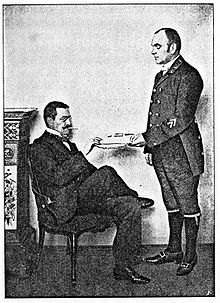servant

A servant (also house servant or valet , with the nobility often a body servant ) is in the traditional sense a member of the household (outdated: a domestica) who fulfills certain domestic duties for his employer or employer.
Labelling

The duties of a valet consisted primarily in the personal service of the master; this is usually the presenting, included cleaning and ironing of clothes , shave , haircut , manicure and purchases and messengers transitions. Sometimes servants also ran the household of their master (as " housekeepers ") and took on tasks such as cleaning, washing and cooking , which were usually done by maids or maids or kitchen staff. All these activities were considered to be “not befitting” for people who were higher in the social hierarchy .
Since the times of the first early and advanced civilizations there have been house servants who were often subordinate to slavery in a dependent relationship , but could also gain social advancement as freed people .
A certain intimacy or trust and the observance of ceremonial, courtly etiquette have always played a major role. Qualities such as courtesy , loyalty , sincerity , discretion, and obedience were important for house servants in direct contact with their rulers . At some imperial or royal courts, valets were those who had direct access to their master and who knew the ruler's private life down to the smallest detail.
At larger courts, the court servants were hierarchically classified according to their activity and organized in the "lower servants". Their livery indicated their rank in the hierarchy. The lower servants divided into court servants and stable servants.
England
The servants in an English household were strictly hierarchical. At the top was the butler , who was given organizational tasks in particular. The remaining male servants were divided between the valets (valet) and Footmen (valet).
A valet , also known as a gentleman's valet , was available to a male family member as a counterpart to the lady's maid . He had tasks such as dressing and changing, serving outside of meal times and personal errands.
The footman, on the other hand, had more general duties; he served at the table, poured drinks or looked after guests. Since he often took on representative tasks (in contrast to the "private" valet ), it was important that he was tall, young and handsome - a taller footman could ask for more wages for his services. Footmen left the service with advancing age or rose to become butlers .
theatre
The servant is also a traditional character of the theater, especially comedy . The Commedia dell'Arte created two different types of servants: the cunning intriguer on the one hand was the naive booby on the other. In the 18th century, a new type of servant emerged: in Italian comedies such as Carlo Goldoni's The Servant of Two Masters (1745) and in opera buffa , such as Leporello in Don Giovanni (1787) or Figaro in The Marriage of Figaro (1784) the servants the caricaturing counterpart to their masters. Here, on the eve of the French Revolution , the servants, who previously appeared only as marginal figures, came more and more into the center of the action.
In the 19th century, however, the servant figure, now mostly as a valet, returned to its traditional function. In the theater, the servant, as a patronizing butler, turned the situation on its head. It was not until the 20th century that Hugo von Hofmannsthal in Der Unbrechliche (1923) and Bertolt Brecht in Herr Puntila und seine Knecht Matti (1940) again made the servant's relationship to his master the main theme.
Known servants
- Paul Burrell (* 1958), servant of Elizabeth II , later the butler of Princess Diana and Prince Charles
- Goethe's servant (summary article)
- Ignatius Fortuna († 1789), " Kammermohr " of Essen princely abbesses
- Lothar Herzog (* 1943), Erich Honecker's steward
- Jost Hoen (1500–1569), servant to Count William the Rich of Nassau-Dillenburg, tutor of the future Prince William of Orange
- Georg Franz Kolschitzky (1640–1694), servant of the imperial envoy Johann Philipp Beris and spy
- Martin Lampe (1734–1806), servant of Immanuel Kant
- Heinz Linge (1913–1980), Adolf Hitler's valet
- Malchus , servant of Caiaphas , the high priest of Israel
- Franz Anton Rosetti (1750–1792), servant and musician in the court orchestra of Prince Kraft Ernst zu Oettingen-Wallerstein, later composer
- Georg Gottfried Rudolph (1778–1840), servant of Friedrich Schiller
- Robert Walser (1878–1956), temporarily servant at Dambrau Castle in 1905 , attended a servants' school in Berlin
literature
- Eberhard Fritz: Servant, coachman, cook, valet, king. On the social history of the royal court in Württemberg (1806 to 1918) . In: Zeitschrift für Württembergische Landesgeschichte , 66/2007, pp. 249–292.
- Eberhard Fritz: The Württemberg court in the early 19th century. On the life of the court servants in the reign of King Friedrich von Württemberg . In: Ludwigsburger Geschichtsblätter , 61/2007, pp. 43–62.
- Thorsten Heese: Of Moors and People. The African servant of the Abbess Johanna Charlotte . In: Historical yearbook for the Herford district , 1997, pp. 67–78
- Dorothea Klenke: Lord and servant in French comedy of the 17th and 18th centuries. A study critical of ideology . Lang, Frankfurt, u. a. 1992, ISBN 3-631-44456-7
- Markus Krajewski: The servant. Media history of a figure between king and client . S. Fischer, Frankfurt am Main 2010, ISBN 978-3-10-038198-9 ( short summary )
- Heinrich XXVIII. Prince Reuss zu Köstritz : The correct servant. Manual for masters and their servants . Parey, Berlin 1900 ( full text at Wikisource )
- Eberhard Fritz: Servants and officials at the Württemberg court, 1806-1918. A biographical directory. Cardamina-Verlag Plaidt 2012. ISBN 978-3-86424-065-2 .
See also
- Servant , lackey , serf , servant , slave
- butler
- Maid , housekeeper
- Altar boy
- Liqueur
- Valet
- Housewife
